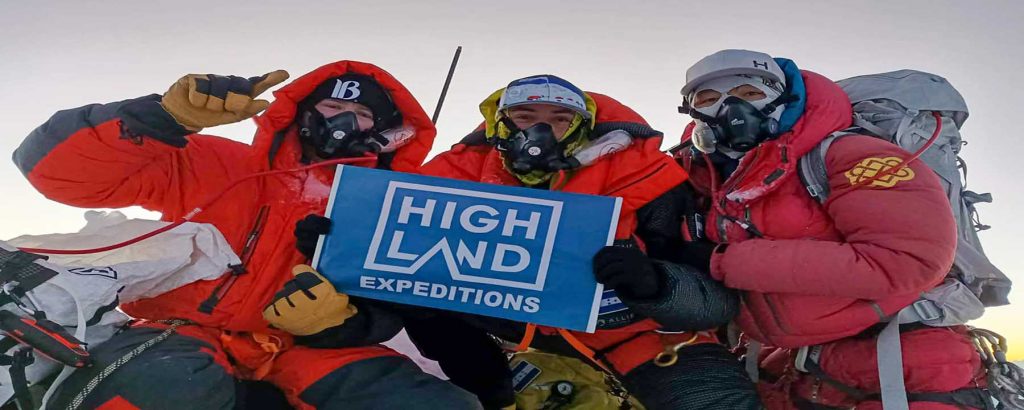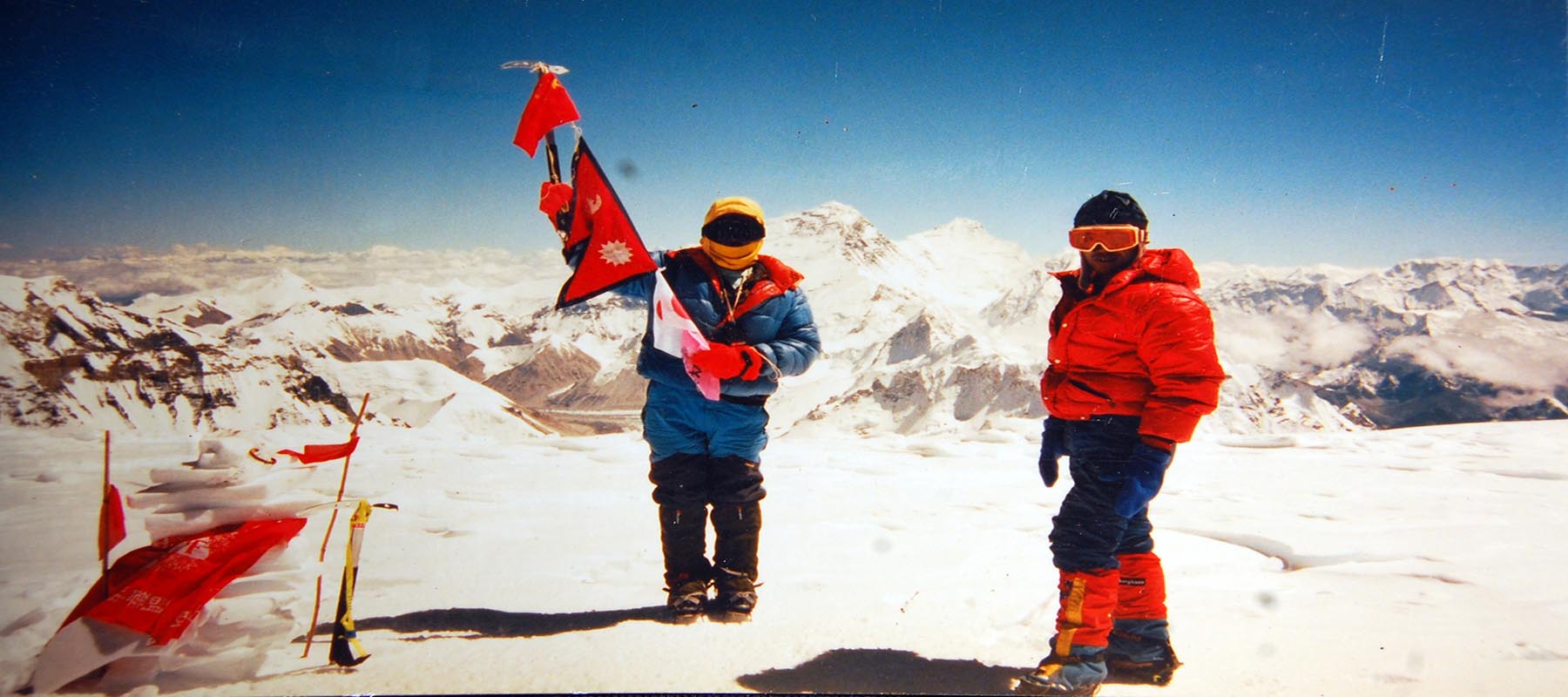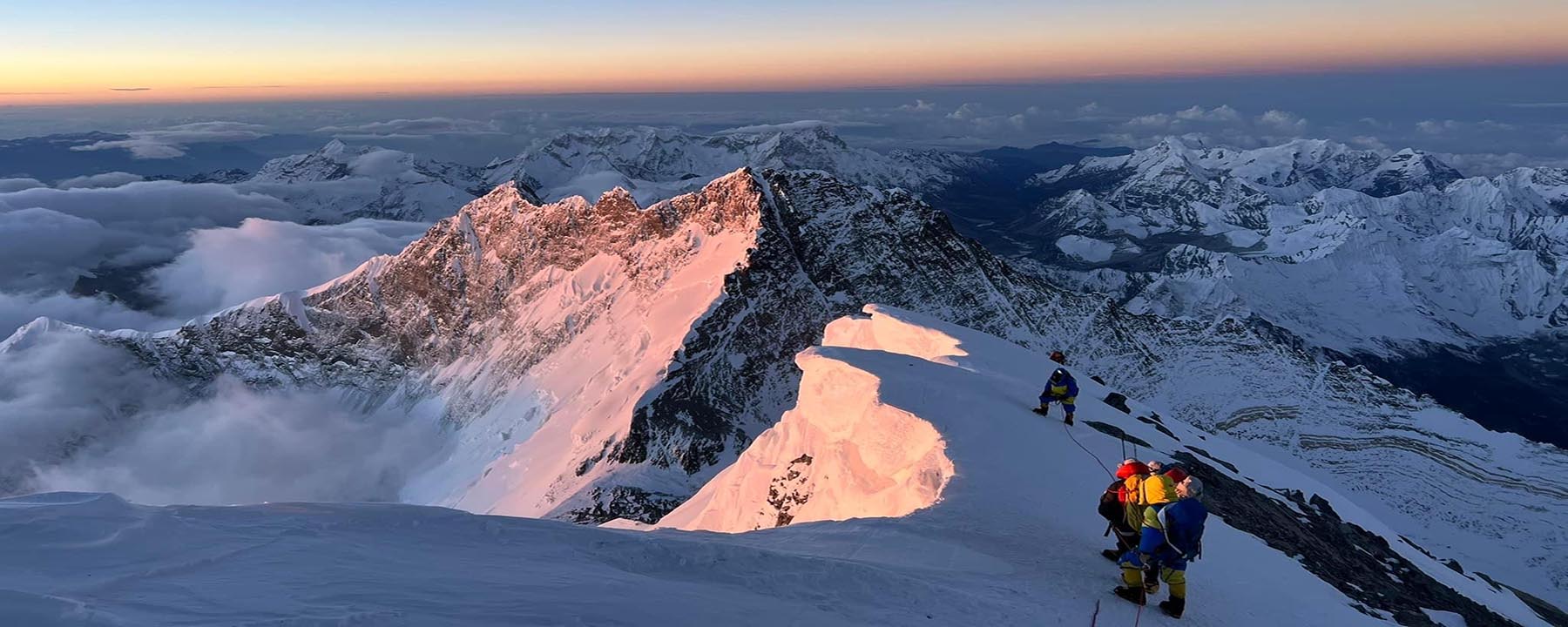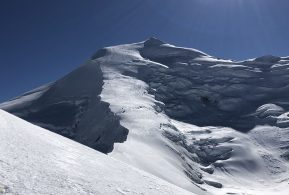Welcome to Highland Everest Expedition 2024.
Over 30 years of experience in high-altitude expeditions
Trip Overview
Highlights
- Climb the highest mountain in the world
- Fully guided expedition with Sherpa support and max O2
- 1:1 Sherpa guide to client ratio and UIAGM/IFMGA expedition leader
- Climb Lobuche East for acclimatization
Everest Expedition 2024 Overview
| Maximum Altitude: | 8,848m/29,029ft |
| Total Duration: | 55 Days |
| Coordinates: | 27.9881° N, 86.9250° E |
| Climbing Route: | South-East Ridge |
| First Ascent: | May 29, 1953 |
| Grade: | Strenuous + |
| Group Size: | Min 1 to Max 8 |
| Activity: | Mountaineering and Climbing |
| Next Date: | 07 April – 31 May 2024 |
Mount Everest [8,848m/29,029ft] being the highest mountain in the world is the ultimate dream of every climber. Climbing to Everest is undoubtedly the ultimate mountaineering adventure and every adventure seeker wants to be a part of the rich history of Everest Climbing but the journey to the summit of Everest is not without challenges. With decades of experience in guiding groups to the summit of Mt. Everest, we have successfully made many people’s dreams come true.
Why Join us on our Everest Expedition 2024?
- Guided by some of the best guides and experienced Sherpa team.
- 1:1 Sherpa guide to client ratio
- Expedition Manager/Sirdar
- Nepalese UIAGM/IFMGA Expedition Leader for a group of 4 climbers and above
- Ascent of Lobuche Peak for acclimatization
- Maximum oxygen flow 11 bottles (8 for you and 3 for your Sherpa)
- Premier climbing experience on Mount Everest
- A cohesive team of climbers (Maximum 8 climbers in one group)
- A long history of high altitude expeditions
Climb Overview
Our Everest expedition itinerary is designed with experience, planned and careful attention allowing maximum days for the approach, the highest level of service and a strong team of guides. We offer expeditions with safety priority and service paramount. We offer more oxygen support and provide comfortable logistics at base camp and Camp 2.
We follow the standard trekking route to Everest base camp following Namche Bazar, Tengboche, Dingboche, Lobuche, Gorekshep and finally Everest base camp. Upon arrival at Base Camp, settle and get organized as we prepare for the actual climb.
A pre-training session /climbing course will be held at the base camp, ice seracs of the lower Khumbu Glacier to check climbers’ equipment and review climbing and rescue techniques. You will also climb Lobuche East as part of your acclimatization climbs instead of frequent rotations in the Khumbu icefall.
Lobuche East is one of the most exciting 6000m trekking peaks in the Everest Region. Lobuche east climb serves as a perfect training base for Everest Expeditions and this is what we would be doing at Highland Expeditions too. You will climb Lobuche East wearing your high-altitude boots and equipment to make you feel comfortable. This peak provides not only an attractive diversion but an excellent part of the acclimatization process while allowing members to refresh and update mountain skills before moving up to Everest.
Climbing Lobuche East Peak prior to the actual Everest climb has not only helped in acclimatization but the climbers will not have to pass through the Khumbu Icefall multiple times for rotation of higher camps. After the climb, we head to base camp and in between looking at an auspicious date as per the Tibetan calendar we will organize a Puja ceremony in a traditional Sherpa manner asking for blessings for a successful Everest Climb.
Our second acclimatization phase begins with the rotation of higher camps passing by the notorious Khumbu icefall. Four camps will be set up above the base camp. We will prepare Camp1 (5,900m/19,500ft) at the pinnacle of the icefall, Camp2 (6,400m/21,000ft) in Western Cwm, which will be our Advanced Base Camp. We will set up Camp 3 (7,300m/23,700ft) at the top of the cirque on Lhotse Face. Camp 4 (7,900m/25,912ft) will be the final camp before climbing the summit. Camp 4 will be placed in the South Col.
Your expedition leader will suggest you the best as per your conditions. In general, our acclimatization program includes overnight at Camp 2 and tagging the Lhotse Face/Camp 3. When this is done, we rest and recover at the base camp while waiting for the weather window for the summit attempt. Oxygen cylinders will be used after Camp 3 for an easy ascent. We provide 8 bottles of oxygen to each climber for maximum flow. From Camp 4, following the southeast ridge, we will make it to the South summit from where we will advance towards Hillary step before climbing to the summit.
Tentative Acclimatization Schedule
First Rotation/Acclimatization (April 21-23):
– Climb Lobuche East Peak (6,119m/20,075ft)
Second Rotation/Acclimatization (April 27- May 03):
– Climb to Camp 1 (5,900m/19,500ft)
– Climb to Camp 2 (6,400m/21,000ft)
– Rest at Camp 2 (6,400m/21,000ft)
– Touch Camp 3 (7,300m/23,700ft) and sleep at Camp 2 (6,400m/21,000ft)
– Descent to base camp (5,364m/17,559ft)
Please note that these acclimatization programs may differ during the expedition period as each climber adapts differently to an altitude.
Summit Push (Weather permitting, most likely May 08-20):
– Climb to Camp 2 (6,400m/21,000ft)
– Climb to Camp 3 with the use of oxygen (7,300m/23,700ft)
– Climb to Camp 4 South Col with the use of oxygen (7,900m/25,912ft)
– Summit push (8,848.86m/29,029ft) and descent to Camp 4 with the use of oxygen
– Descent to Camp 2 (6,400m/21,000ft)
– Descent to Base Camp (5,364m/17,559ft)
Why climb Everest with us?
Over the last 30yrs, the people who helm this venture have been successfully organizing high-altitude Expeditions ensuring safety first and service paramount. The success of any expedition depends largely on a carefully planned itinerary and the best logistics and, these are what we offer. We are committed to maintaining the expedition safe and successful with the quality of service.
Our emphasis is always on maintaining the small group so that it will be easy to coordinate and cooperate with each other. You will be guided by highly professional mountain guides who are one of the best in this field and has experience successfully climbing Everest multiple times. Our guides, Sherpas, and support staff bring decades of successful summits to the table, and our climbing strategy reflects this.
Each year, we provide fully guided expeditions with the support of the legendary Sherpas. Our 1 to 1 Sherpa to client ratio with an expedition leader to lead the team on summit days show our commitment to providing safe climbing strategies.
Compared to the facilities we provide; you will find our Everest Expedition cost to be very reasonable. We have no hidden fee. What you pay in the beginning is the final payment. We are dedicated to providing the highest professionalism throughout the expedition by taking utmost care of all the logistics needed for our Everest Expedition.

Expedition Manager/Guide
Our Everest Expedition 2024 will be managed by Kunga Sherpa, an Everest summiteer and avid climber himself. With over 35 years of experience in the climbing industry, he has managed over forty above 8000m expeditions to date with a 90% success ratio.
For 2024, our Everest Expedition leader will be a Nepalese UIAGM/IFMGA Guide.
1:1 Sherpa to client ratio on summit day
Most of our Sherpa guides come from Rolwaling and Thame. All our Sherpa guides are previous Everest summiteers with detailed experience on high-altitude expeditions. We provide a 1:1 sherpa guide-to-client ratio on the summit day. Each of our Sherpa guides has tons of experience in climbing high-altitude peaks.
Our Sherpa crews are critical to the success of the climbs that you do with us. We, us professionally trained Sherpa guides & sirdars are just not hikers & climbers on the mountains but have been trained to perform this task with a lot of common sense & guile. Kunga Sherpa, Everest summiteer and founder of Highland Expeditions has successfully guided and organized over 40 expeditions to 8000m as an expedition sirdar oversees our experienced Sherpa crew that will be with you on the climb.
We ensure that they are confident & experienced. Most of our guides were born in these parts & have relatives living in other parts of the regions where they were born in. We know that locally born staffs are a vital cog in that wheel of sometimes dangerous adventure where anything can happen. At Highland Expeditions, we always make sure that our mountain crews are highly motivated & never compromise.
Local company with decades of high altitude experience

Highland Expeditions is a fully licensed and registered company operating high-altitude trips in the Himalayas. The people who helm this venture have been guiding high-altitude expeditions since 1992 and we take great pride in being able to offer personalized expeditions to Mt. Everest with safety priority and service paramount.
We operate a small team of cohesive climbers with the support of our experienced sherpa guides who have all summited Everest previously. We only take 8 climbers in a team and provide the Nepali UIAGM/IFMGA Expedition leader with a 1:1 sherpa guide-to-client ratio with maximum oxygen support and comfortable logistics arrangements.
Join us and be a part of the ‘Highland Expeditions family. It’s a never-ending feeling that will live with the generations to come.
Important Note: Your safety is of imperative concern while travelling with Highland Expeditions. Please take care to note that your leader/guide has the authority to amend or cancel any part of the itinerary if it is deemed necessary due to your safety concerns. Every effort will be made to keep to the above itinerary; however, since this adventure entails travelling in remote mountainous regions, we cannot guarantee that we will not deviate from it. Weather or health condition of a group member, unexpected natural disasters, etc., can all contribute to changes in the itinerary. The Trek & Climb leader/guide will try to ensure that the trip runs according to plan, but please be prepared to be flexible if required.
Trip Itinerary
Dates & Price
Our trips are available on both fixed departure and private group basis.
If you are looking for a group to join this trip please click the Fixed Departures tab for more information on departure dates, availability and price. All our fixed departures are guaranteed to run. Or, if you would like to do this trip alone, or with your friends, families & colleagues in a private group style, please fill out the contact form in Private Group tab and send us your message. We will organize a private trip for you at your preferred dates catering any request you may have.
Cost Inclusion
- Everest expedition royalty fees (USD 11,000)
- Route fixing (SPCC and EOA) fees
- Garbage deposit and management fees
- Expedition Liaison Officer wages and fees
- Nepalese UIAGM/IFMGA Expedition leader for a group of 4 climbers and above
- 1:1 Sherpa guide (Everest Summiter) to climber ratio
- Service of the Expedition manager at Everest base camp
- 11 bottles of oxygen (8 for you and 3 for your sherpa) with the use of the latest mask and regulator.
- Skill training clinic at the Everest base camp
- The ascent of Lobuche Peak for acclimatization with a 1:3 guide to client ratio
- Freshly prepared meals (B,L,D) by our chef at the Everest base camp
- A wide variety of nutritious high-altitude mountain foods for higher camps
- Individual box tent, dining tent, kitchen tent, toilet tent and other logistics
- Heater, Generator, Shower and more for your comfort at the base camp
- High altitude tent (North Face VE25 or similar) for higher camps above base camp
- 4 nights accommodation at a 4-star hotel in Kathmandu.
- All Meals (B,L,D) and accommodation during the trekking period
- Satellite communication system at base camp but nominal charge for use
- Radio set for communication between camps
- Internal domestic airfare with 60kg baggage cargo
- Staffs wages, allowances with their helicopter and medical insurance
- Common climbing equipment (rope, Ice Screws, Snow bars etc)
- Weather report during the entire expedition period
- Emergency medical supplies with 24/7 on-call doctor during the entire expedition period.
- Porterage of 60kg baggage for each member (Lukla-Base camp-Lukla)
- 2 waterproof duffel bags
- Everest Summit certificate from the Department of Tourism, Nepal
Cost Exclusion
- International airfare
- Meals in Kathmandu
- Custom for bringing any expedition goods
- Nepal visa fees
- Personal clothing and climbing equipment
- Insurance (Mandatory)
- Summit bonus (USD 1500)
- Gratuities for base camp and trekking staff
- Personal expenses
- Extra oxygen aside from provided 11 bottles
Essential Information
Reviews

A great local company that looks after you, its guides and its staff. I have done Ama Dablam and Everest with them. Both were very well-run expeditions and led to successful summits. Thank Passang and the Highlands team for all your efforts for the airport pick-up to reaching my goal. Can’t recommend these guys enough.

 Strenuous +
Strenuous +








